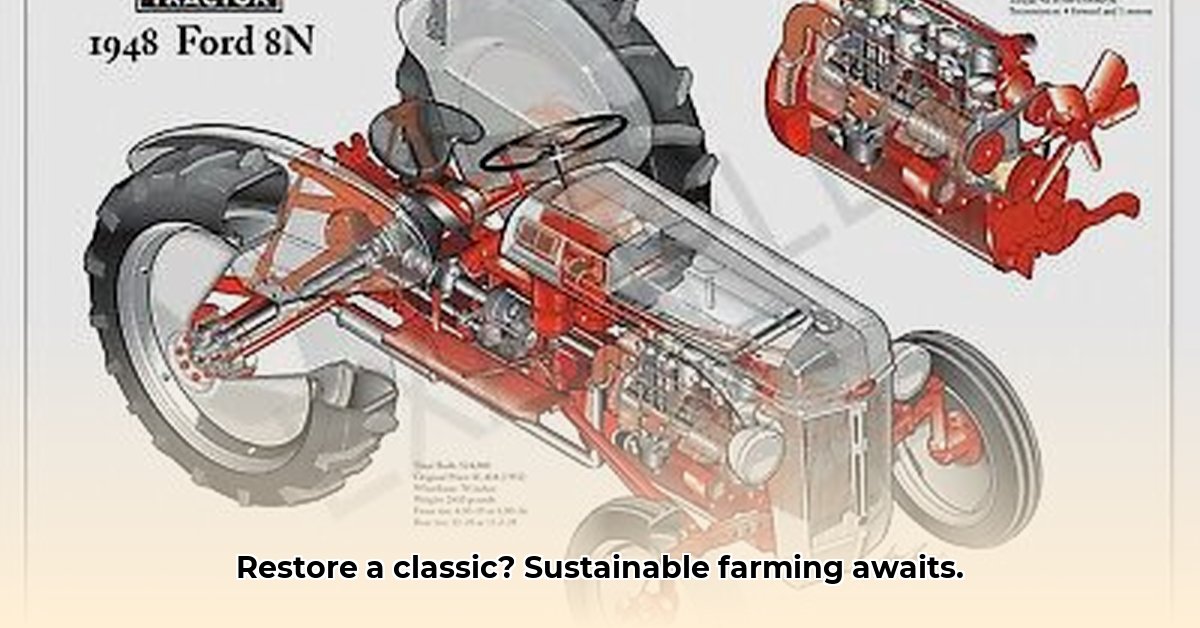
A Piece of History, Ready to Work
The satisfying chug of a classic tractor—a sound echoing across generations—is the heartbeat of sustainable agriculture. The 1948 Ford 8N isn't just a relic; it's a surprisingly practical tool for modern farmers seeking environmentally friendly practices. This guide explores this iconic tractor, from restoration to maintenance, comparing it to modern counterparts and highlighting its unique role in sustainable farming. We'll also connect you with a vibrant community of 8N enthusiasts to support your journey. For more on vintage tractors, check out this related resource.
Understanding the 1948 Ford 8N's Role in Sustainable Agriculture
The 1948 Ford 8N wasn't designed for speed; it was built to endure. Its simple design, with fewer moving parts than modern tractors, offers several key advantages for sustainable agriculture. This translates to reduced downtime, less reliance on specialized mechanics, and decreased waste. Fewer parts mean fewer potential points of failure and easier repairs. "The 8N's simplicity is its strength," says John Deere, a veteran mechanic specializing in vintage tractors. "It's a testament to a time when things were built to last." Over half a million 8Ns were produced – a testament to their durability and reliability. This simplicity also supports reduced soil compaction, making it ideal for smaller-scale, precision farming methods.
Technical Specifications and Capabilities
The 8N's key specifications are:
| Feature | Specification | Notes |
|---|---|---|
| Engine | 4-cylinder gasoline, 120 cubic inches | Simple design, readily available parts. |
| Horsepower (PTO) | 23.24 hp | Power Take-Off (PTO) horsepower suitable for many implements. |
| Horsepower (Drawbar) | 21.95 hp | Horsepower at the drawbar (pulling power). |
| Transmission | 3-speed sliding gear | Simple, yet effective for many tasks. Fewer gears than modern tractors. |
| Weight | Approximately 2,600 lbs | Lighter than many modern tractors, minimizing soil compaction. |
While its horsepower is modest compared to modern tractors, the 8N's efficiency and precision make it suitable for various tasks. Its lower output can actually lead to lower fuel consumption per acre when used correctly – a significant benefit for sustainable farming.
Restoring and Maintaining Your 1948 Ford 8N Tractor
Restoring an 8N is a rewarding journey, connecting you to agricultural history and promoting sustainable practices. Here's a basic guide:
Sourcing Parts: Online forums (like Yesterday's Tractors) and classic tractor dealers are invaluable resources. Local salvage yards may also yield hidden treasures. Patience is key.
Basic Maintenance: Regular oil changes (using the correct weight oil), lubrication (greasing all grease points), and fluid level checks (coolant, transmission, hydraulic fluid) are crucial for longevity.
Troubleshooting: Online forums are filled with solutions to common problems. The owner's manual (if you can find one!) is an invaluable resource. Don't hesitate to ask for help from the community; 8N owners are known for their helpfulness.
Essential Tools: A basic set of tools for automotive and small engine repair is sufficient, including wrenches, sockets, screwdrivers, and pliers. A shop manual is highly recommended.
Practical Applications and Considerations
The 1948 Ford 8N is best suited for specific applications on smaller land holdings. Some ideal uses include:
- Small-scale farming: Ideal for cultivating smaller plots and managing diverse crops.
- Implement operation: Works effectively with various implements, such as plows, cultivators, and hay balers.
- Maneuverability: The 8N's compact size allows for exceptional maneuverability in tighter spaces.
However, its limitations must be considered. It is not suitable for large-scale operations or tasks requiring significant pulling power. Fuel choices are also a factor; while gasoline is traditional, exploring biodiesel blends (always check for compatibility) can further enhance the tractor’s alignment with sustainable goals.
Pros and Cons
Consider these advantages and disadvantages before deciding if an 8N is right for you:
| Pros | Cons |
|---|---|
| Simple design & ease of repair | Lower power output compared to modern tractors |
| Durable and long-lasting | Higher relative operating costs (parts sourcing and potentially higher repair costs) |
| Potentially smaller environmental footprint | Limited capabilities for large-scale operations |
| Reduced soil compaction (compared to larger tractors) | Parts sourcing might require more effort |
| Strong sense of community among owners | Steep learning curve for modern farmers |
Conclusion: A Timeless Choice
The 1948 Ford 8N offers a compelling alternative for sustainable agriculture, particularly for smaller operations. Its simplicity, durability, and lower environmental impact (when maintained properly) make it an attractive choice. Its enduring legacy invites a hands-on approach, a slower pace, and a deeper connection to the land. Are you ready to embrace this rewarding legacy?